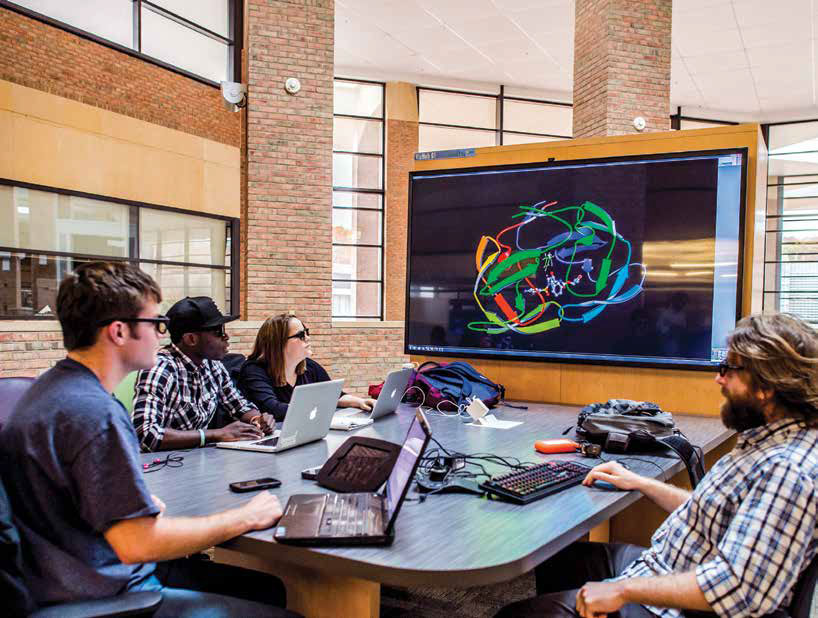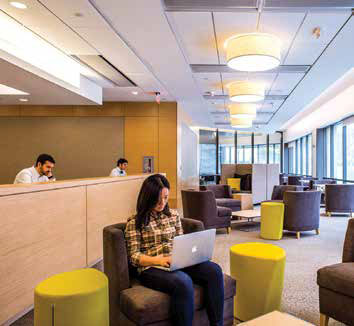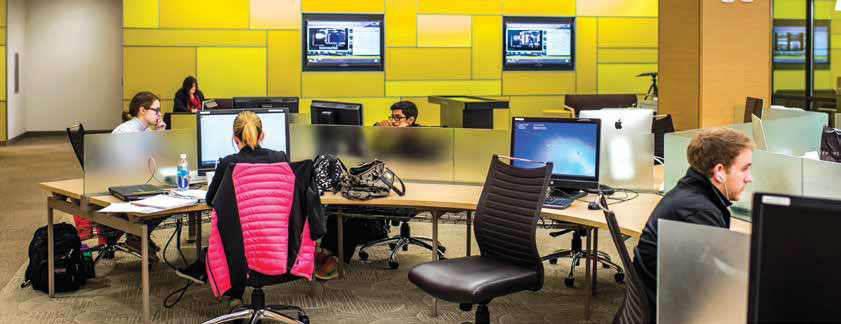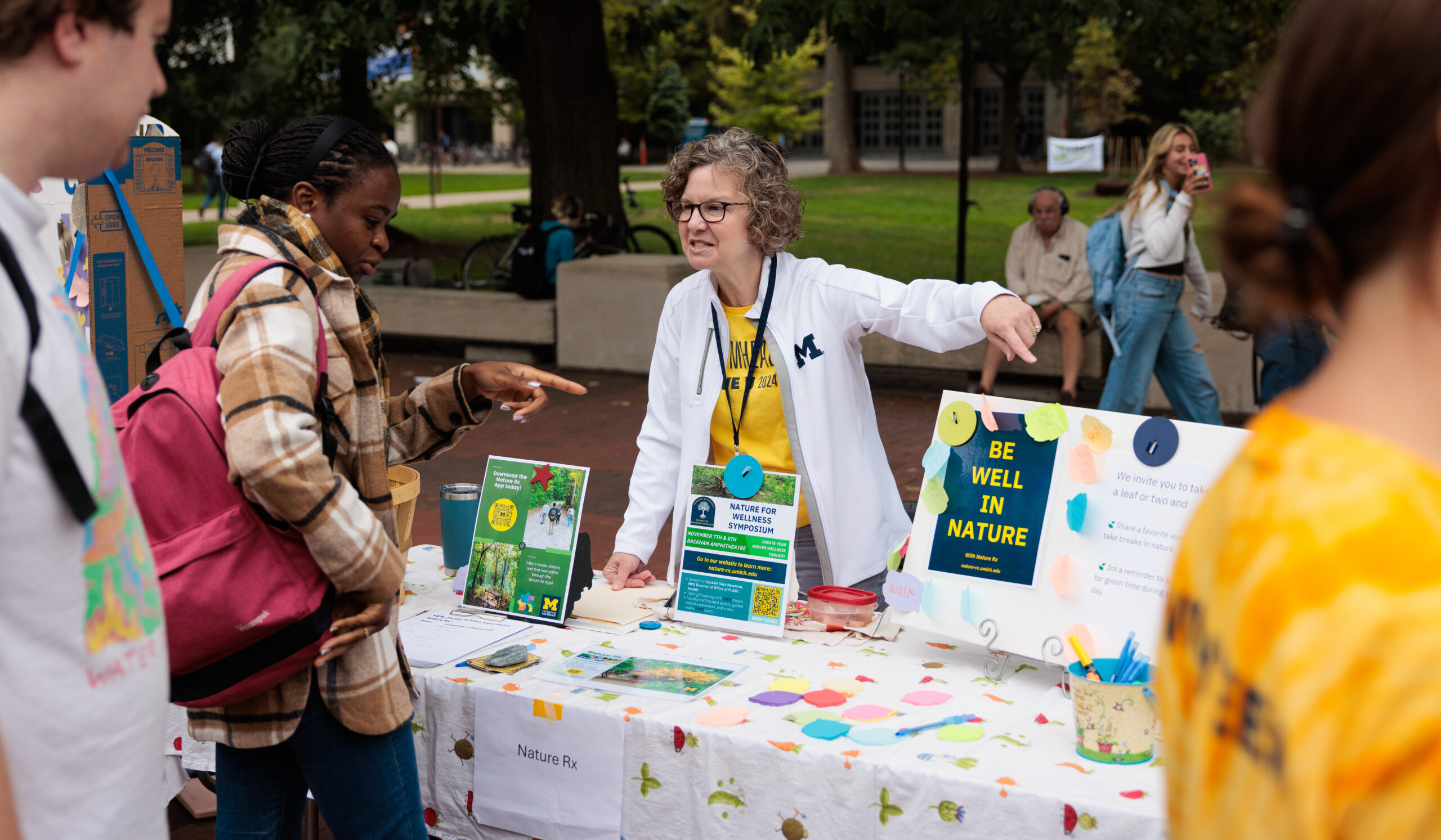U-M’s libraries are not just flourishing, they’re futuristic — embracing the latest technologies and trends in design while maintaining their ultimate mission of enabling and empowering discovery.
At first glance, the newly renovated Taubman Health Sciences Library could easily be mistaken for a lounge. Visitors are surrounded by a wall of windows, sleek tiled walkways, potted plants, bright yellow walls, and flat screen televisions. Even the furnishings look worthy of a boutique hotel — plush brown couches accented by funky side tables, dramatic high-backed chairs softened with throw pillows, and cubicles encircling loveseats. Missing are endless shelves of books, card catalogs, and shushing librarians. The only obvious allusion to an academic environment is the reference desk — staffed by health science librarians called “informationists” — as well as an area of carrels next to a long bar with stools. Both are outfitted with a plethora of plugs: a laptop necessity for what is now a nearly all-digital collection.

Welcome to the University’s newest state-of-the-art library, which reopened in July following a $55 million renovation. Located on the upper floors of the 143,000-square-foot facility are everything from clinical practice rooms, where medical students can treat actors portraying patients, to classrooms where the walls and tables are white boards. But it is on the ground floor that one finds the library’s ultimate curiosity, a virtual cadaver ready to be dissected with the swipe of a finger.
“We are going to have a contest to name him,” says Jane Blumenthal, director of the library. She slices the $75,000, life-size computerized man in half, revealing a colorful bisection of his torso. “Amazing, isn’t it?” she says, her enthusiasm contagious.
The revamped 35-year-old Taubman library is just the latest example of how the University has stayed on the cutting edge of exploration and engaged learning for decades. From the 1981 unveiling of the underground Law Library, to the renovation of the Shapiro Undergraduate Library in 1995 and the opening of the Duderstadt Center in 1996, U-M has invested in the latest technologies and design features. And the goal has remained the same: to provide the best infrastructure of scholarship possible for U-M students, faculty, and staff as well as the general public.
“It’s funny because people often say to me that libraries are so 20th century,” says James Hilton, dean of libraries at U-M. While the term “library” can refer to everything from a building or floor to a collection of papers, films, or objects, the “official” number of University libraries (meaning those with staffed service desks) numbers 19. Hilton, appropriately, works in the largest one, the Hatcher Graduate Library, which houses a quarter of the University’s 8 million-volume collection on campus. The smallest, U-M’s Biological Station Library, is four hours away in Pellston, Mich. “A library’s mission is to enable and empower discoveries, chronicle them, and then preserve those discoveries for future generations. That will never change.”
Whether those discoveries take place in the quietest campus reading room at Hatcher, the temperature controlled areas of the Papyrology Collection, or the bustling Design Lab at the Duderstadt Center makes no difference to Hilton. What is important to him, and surprising to many, is the popularity of the library spaces, considering how much of U-M’s collection is now available online.
Last year, U-M libraries tallied up more than 4.5 million visitors and the student government requested 100 more seats be added to the undergraduate library during exams. “If you walk into the library on a Saturday night during finals, you can’t believe how packed it is,” Hilton says, adding that even in this digital age the libraries saw close to 1 million volumes physically circulated.
Scott Dennis, who manages the general reference collection at Hatcher, has a theory that his boss supports. “I think the library provides a sort of neutral space where everyone feels welcome and equally justified in being there, like Switzerland,” he says. “But what we are also seeing is that the space is not as determinate of what they do. Everyone floats all around and gravitates to the spaces and environments they prefer. Medical students study here at Hatcher, and Ross business students study at the Duderstadt. Everyone is coming together across different disciplines and collaborating.”
That is why the new Taubman library has so many study rooms, lounges, and classrooms with mobile furniture and wall monitors — so that students can work together. Or as Blumenthal acknowledges, “You have to understand that we did not change the space so the students would use it differently. We noticed how the students were using the space differently and changed it to be compatible to them.”

For the same reason, the second floor of the Duderstadt Center now has a Visualization Hub comprising 13 workstations developed in collaboration with the College of Engineering. All have 55-inch wall monitors the students can plug their laptops into for screen sharing, and two have particularly high resolution displays and mega-gigabyte network access. “We used to have a lot of individual cubbies here on the second floor,” explains Daniel Fessahazion. He helps manage the space that is shared by the Digital Media Commons; the Art, Architecture, and Engineering Library; and the College of Engineering. “But then in the morning we would arrive and find the students had actually physically removed the partitions between the desks so they could work together,” he recalls, laughing.
“Now we can put a designer, engineer, and music person together at one of these stations so they can work in a cross-disciplinary mode,” Fessahazion says. He adds that collaboration is the mission behind the high-tech library that he manages — the Digital Media Commons, otherwise known as “the coolest library on campus.”
So it would seem, judging by the equipment: a $700,000 analog console audio studio, one of only a couple dozen in the world; a video studio that would cost roughly $40,000 to $50,000 a week to rent in New York; a 3-D printing lab; a makerspace; and even a virtual reality room, called the “Miden,” where students can explore any environment they can project from a computer onto its three screens. In the Miden, one can upload an architectural drawing, natural disaster landscape, or image of the universe and then, with the help of a joystick and special glasses, walk through the created space.
“I think of us as Sherpas through the digital landscape,” says Eric Maslowski, co-director of the Digital Media Commons, as he explains how one project involved students capturing a data stream of brain waves, setting them to music, and then making a film of the Mind Ensemble performance that ensued. “You see students pushing the technology in the most amazing ways.”
Hilton adds, “Libraries give individuals access to tools that on their own they could never afford.” He cites, among other U-M treasures, the HathiTrust, 13 million titles digitized from libraries all over the world, thanks to a partnership of academic and research institutions. Four million of those Hathi books are at the University, preserved for future generations just as old newspaper reels can still be read on microfiche machines in the Hatcher Library and CD-ROMs can be converted to new formats at the Duderstadt Center. Conservation, Hilton points out, is one of the most important jobs of research libraries, particularly when the collection includes 60 pages of the oldest known copy of the Epistles of Paul, as U-M’s does.

Perhaps most telling has been how students and faculty react when their study space is taken away. Though Taubman has now reopened, the Kresge Business Administration Library at the Ross School of Business lost its student study space more than a year ago and soon after moved its collections to other libraries on campus. Now called Kresge Library Services and located in temporary quarters, it will move into its permanent quarters when the new Kresge building is completed in the fall of 2016. The space, however, will be vastly reduced. Given that the previous library was 27,000 square feet and held a collection of 70,000 books while the new space will be 5,000 square feet and hold only 200 books, it is understandable that library director Corey Seeman feels a bit nostalgic.
“We will no longer have a student space or a print capacity, but we are looking at this as an opportunity for new roles,” says Seeman, whose staff of 19 will continue to assist faculty and staff with research. “Books are just one way to recognize content.” As for the business students, who are currently packing themselves into the Davidson Winter Garden on the ground floor of the Ross Business School (“looking like passengers waiting for a delayed flight,” says Seeman), they will have new study spaces in other parts of the new building.
Still, as Blumenthal says standing next to her library’s new virtual cadaver, “You can’t hold onto how libraries were 50 years ago. It doesn’t work. Smart libraries and smart librarians know they have to grow with the times. And it is exciting.”
A Library Walking Tour of Discovery and Design
Library lovers take note — you don’t have to check out a book to enjoy the U-M Libraries because they are open to the public. Take this walking tour of the most traditional, trendy, and technical libraries on campus.
- Start your tour at the Law Quad, specifically the reading room, recently named the most amazing college library in the country by CollegeRank.net. One of the most superb examples of a Collegiate Gothic building, it never fails to make visitors gasp at its beauty.
- For a blast to the past, head over to the Shapiro Undergraduate Library. Alumni over 40 will be shocked: the UGLi is not so ugly anymore. Its 90s facelift included a new lobby and café. Grab a coffee and watch the undergrad action close up.
- Continue on to the Hatcher Graduate Library, which houses the primary research collection for the humanities and social sciences. Check out the Audubon Room on the first floor, where student-archived exhibits take place and you can usually find a rare document on display from the Papyrology Collection. Head up to the second floor to one of the quietest, and most beautiful, reading rooms on campus.
- If maps are your passion, you will love the Clark Library, located steps away on the same floor. But the Clark also has an exhibit space, which showcases student art, a visual representation of a master’s thesis, and parts of the map collection. A recent exhibit showcased travel and dining through the decades.
- Before leaving the Hatcher, head to the seventh floor exhibit space. This is where you can always find an exhibit from the Special Collections Library, which has internationally renowned collections of books, manuscripts, archival, and other material.
- If you have ever dreamed of being a surgeon, try your skills out on the virtual cadaver on the ground floor of the new Taubman Health Sciences Library. Feel free to slice and dice him or just explore his innards. He is as colorful as the library décor.
- Curious about new technologies, or have a project in mind but not sure where to start? Take the bus to North Campus and check out the Digital Media Commons in the Duderstadt Center. Look around and you will see students hard at work in the UM3D Lab, maker space area, and various studios. It might not look like a library, but it is!
Jennifer Conlin, ’83, is the deputy editor of Michigan Alumnus magazine whose work has predominantly appeared in The New York Times.





